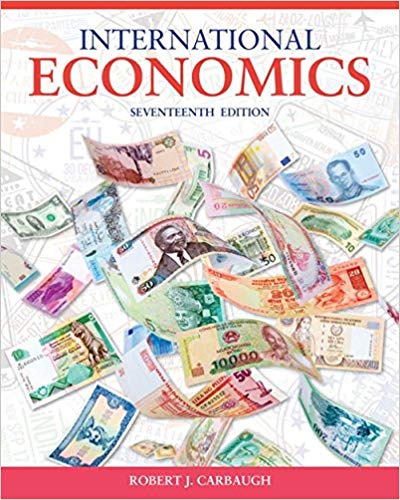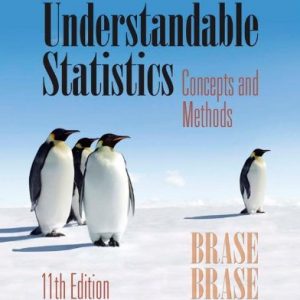This is completed downloadable of Solution Manual for International Economics 17th Edition

Product Details:
- ISBN-10 : 1337558931
- ISBN-13 : 978-1337558938
- Author:
Discover the proven, market-leading text that is a favorite among students of all backgrounds for its clear, concise treatment of international trade and finance theory. Carbaugh’s INTERNATIONAL ECONOMICS, 17E uses a wealth of contemporary examples and practical applications to vividly demonstrate the relevance of the theory you are learning to real economic issues and global policy questions. The author presents both written and graphical discussions, making the book highly understandable even if you have little economics background. This edition reflects the latest theoretical developments with a continued emphasis on current applications to keep your instruction current and interesting. You will soon discover, “If it’s clear, concise, and contemporary, it has to be Carbaugh.”
Table of Content:
- PART 1: International Trade Relations
- CHAPTER 1: The International Economy and Globalization
- Economic Interdependence: Federal Reserve Policy Incites Global Backlash
- Globalization of Economic Activity
- U.S. Apple Growers Not Overly Worried about Chinese Imports
- Waves of Globalization
- First Wave of Globalization: 1870–1914
- Second Wave of Globalization: 1945–1980
- Latest Wave of Globalization
- Diesel Engines and Gas Turbines as Movers of Globalization
- The United States as an Open Economy
- Trade Patterns
- Labor and Capital
- Why Is Globalization Important?
- Globalization and Competition
- Globalization Forces Kodak to Reinvent Itself
- Bicycle Imports Force Schwinn to Downshift
- Element Electronics Survives by Moving TV Production to America
- Common Fallacies of International Trade
- Is the United States Losing Its Innovation Edge?
- Is International Trade an Opportunity or a Threat to Workers?
- Has Globalization Gone Too Far?
- The Plan of This Text
- Summary
- Key Concepts and Terms
- Study Questions
- CHAPTER 2: Foundations of Modern Trade Theory: Comparative Advantage
- Historical Development of Modern Trade Theory
- The Mercantilists
- Why Nations Trade: Absolute Advantage
- Adam Smith and David Ricardo
- Why Nations Trade: Comparative Advantage
- Production Possibilities Frontiers
- Trading under Constant-Cost Conditions
- Basis for Trade and Direction of Trade
- Production Gains from Specialization
- Babe Ruth and the Principle of Comparative Advantage
- Consumption Gains from Trade
- Distributing the Gains from Trade
- Equilibrium Terms of Trade
- Terms of Trade Estimates
- Dynamic Gains from Trade: Economic Growth
- Changing Comparative Advantage
- Natural Gas Boom Fuels Debate
- Trading under Increasing-Cost Conditions
- Increasing-Cost Trading Case
- Partial Specialization
- The Impact of Trade on Jobs
- Wooster, Ohio Bears the Brunt of Globalization
- Comparative Advantage Extended to Many Products and Countries
- More Than Two Products
- More Than Two Countries
- Factor Mobility, Exit Barriers, and Trade
- Empirical Evidence on Comparative Advantage
- Can American Workers Compete with Low-Wage Workers Abroad?
- The Case for Free Trade
- Comparative Advantage and Global Supply Chains
- Advantages and Disadvantages of Outsourcing
- Outsourcing and the U.S. Automobile Industry
- The iPhone Economy and Global Supply Chains
- Outsourcing Backfires for Boeing 787 Dreamliner
- Reshoring Production to the United States
- Deindustrialization Redeploys Workers to Growing Service Sector
- Summary
- Key Concepts and Terms
- Study Questions
- CHAPTER 3: Sources of Comparative Advantage
- Factor Endowments as a Source of Comparative Advantage
- The Factor-Endowment Theory
- Visualizing the Factor-Endowment Theory
- Applying the Factor-Endowment Theory to U.S.–China Trade
- Chinese Manufacturers Beset by Rising Wages and a Rising Yuan
- Does Trade with China Take Away Blue-Collar American Jobs?
- Factor-Price Equalization
- Globalization Drives Changes for U.S. Automakers
- Is International Trade a Substitute for Migration?
- Specific-Factors Theory: Trade and the Distribution of Income
- Does Trade Make the Poor Even Poorer?
- Is International Trade Responsible for the Loss of American Manufacturing Jobs? How about Robots
- Is the Factor-Endowment Theory a Good Predictor of Trade Patterns? The Leontief Paradox
- Economies of Scale and Comparative Advantage
- Internal Economies of Scale
- External Economies of Scale
- Does a “Flat World” Make Ricardo Wrong?
- Overlapping Demands as a Basis for Trade
- Intra-industry Trade
- Technology as a Source of Comparative Advantage: The Product Cycle Theory
- Radios, Pocket Calculators, and the International Product Cycle
- Japan Fades in the Electronics Industry
- Dynamic Comparative Advantage: Industrial Policy
- World Trade Organization Rules That Illegal Government Subsidies Support Boeing and Airbus
- Government Regulatory Policies and Comparative Advantage
- Do Labor Unions Stifle Competitiveness?
- Transportation Costs and Comparative Advantage
- Trade Effects
- Falling Transportation Costs Foster Trade
- How Containers Revolutionized the World of Shipping
- The Port of Prince Rupert: Shifting Competitiveness in Shipping Routes
- Summary
- Key Concepts and Terms
- Study Questions
- CHAPTER 4: Tariffs
- The Tariff Concept
- Types of Tariffs
- Specific Tariff
- Ad Valorem Tariff
- Compound Tariff
- Trade Protectionism Intensifies as Global Economy Falls into the Great Recession
- Effective Rate of Protection
- Tariff Escalation
- Outsourcing and Offshore Assembly Provision
- Dodging Import Tariffs: Tariff Avoidance and Tariff Evasion
- Ford Strips Its Wagons to Avoid a High Tariff
- Smuggled Steel Evades U.S. Tariffs
- Postponing Import Tariffs
- Gains from Eliminating Import Tariffs
- Bonded Warehouse
- Foreign-Trade Zone
- FTZs Benefit Motor Vehicle Importers
- Tariff Effects: An Overview
- Tariff Welfare Effects: Consumer Surplus and Producer Surplus
- Tariff Welfare Effects: Small-Nation Model
- Tariff Welfare Effects: Large-Nation Model
- Donald Trump’s Border Tax: How to Pay for the Wall
- The Optimal Tariff and Retaliation
- Examples of U.S. Tariffs
- Obama’s Tariffs on Chinese Tires
- Should Footwear Tariffs Be Given the Boot?
- Could a Higher Tariff Put a Dent in the Federal Debt?
- How a Tariff Burdens Exporters
- Tariffs and the Poor: Regressive Tariffs
- Arguments for Trade Restrictions
- Job Protection
- Protection against Cheap Foreign Labor
- Fairness in Trade: A Level Playing Field
- Maintenance of the Domestic Standard of Living
- Equalization of Production Costs
- Infant-Industry Argument
- Noneconomic Arguments
- Would a Tariff Wall Really Protect U.S. Jobs?
- Petition of the Candle Makers
- The Political Economy of Protectionism
- A Supply and Demand View of Protectionism
- Summary
- Key Concepts and Terms
- Study Questions
- CHAPTER 5: Nontariff Trade Barriers
- Absolute Import Quota
- Trade and Welfare Effects
- Allocating Quota Licenses
- Quotas versus Tariffs
- Tariff-Rate Quota: A Two-Tier Tariff
- Tariff-Rate Quota Bittersweet for Sugar Consumers
- Export Quotas
- Japanese Auto Restraints Put Brakes on U.S. Motorists
- Domestic Content Requirements
- How American Is Your Car?
- Subsidies
- Domestic Production Subsidy
- Export Subsidy
- Dumping
- Forms of Dumping
- International Price Discrimination
- Avoiding Antidumping Duties: U.S.–Mexico Sugar Agreement
- Antidumping Regulations
- Whirlpool Agitates for Antidumping Tariffs on Clothes Washers
- Vaughan-Bassett Furniture Company: Furniture Dumping from China
- Is Antidumping Law Unfair?
- Should Average Variable Cost Be the Yardstick for Defining Dumping?
- Should Antidumping Law Reflect Currency Fluctuations?
- Are Antidumping Duties Overused?
- Other Nontariff Trade Barriers
- Government Procurement Policies: “Buy American”
- U.S. Fiscal Stimulus and Buy American Legislation
- Social Regulations
- CAFE Standards
- Europe Has a Cow over Hormone-Treated U.S. Beef
- Sea Transport and Freight Regulations
- Summary
- Key Concepts and Terms
- Study Questions
- CHAPTER 6: Trade Regulations and Industrial Policies
- U.S. Tariff Policies Before 1930
- Smoot–Hawley Act
- Reciprocal Trade Agreements Act
- General Agreement on Tariffs and Trade
- Trade without Discrimination
- Promoting Freer Trade
- Predictability: Through Binding and Transparency
- Multilateral Trade Negotiations
- Avoiding Trade Barriers during the Great Recession
- World Trade Organization
- Settling Trade Disputes
- Does the WTO Reduce National Sovereignty?
- Does the WTO Harm the Environment?
- Harming the Environment
- Improving the Environment
- WTO Rules against China’s Hoarding of Rare Earth Metals
- Future of the World Trade Organization
- Trade Promotion Authority (Fast Track Authority)
- Safeguards (The Escape Clause): Emergency Protection from Imports
- U.S. Safeguards Limit Surging Imports of Textiles from China
- Countervailing Duties: Protection against Foreign Export Subsidies
- Countervailing Duties: Trade Disputes between Canada and the United States
- Would a Carbon Tariff Help Solve the Climate Problem?
- Antidumping Duties: Protection against Foreign Dumping
- Remedies against Dumped and Subsidized Imports
- U.S. Steel Companies Lose an Unfair Trade Case and Still Win
- Section 301: Protection against Unfair Trading Practices
- Protection of Intellectual Property Rights
- China’s Piracy of Software
- Trade Adjustment Assistance
- Trade Adjustment Assistance for Workers, Firms, Farmers, and Fishermen
- Is Trade Adjustment Assistance Necessary?
- United States Lifts Its Restrictions on Oil Exports
- Industrial Policies of the United States
- The Export-Import Bank
- U.S. Airlines and Boeing Spar over Export-Import Bank Credit
- U.S. Solar Industry Dims as China’s Industrial Policy Lights Up
- Carrier Inc. Agrees to Keep Jobs in Indiana
- Strategic Trade Policy
- Economic Sanctions
- Factors Influencing the Success of Sanctions
- Sanctions and Nuclear Weapons: Iran and North Korea
- Russia Hit by Sanctions over Ukraine
- Summary
- Key Concepts and Terms
- Study Questions
- CHAPTER 7: Trade Policies for the Developing Nations
- Developing Nation Trade Characteristics
- Tensions between Developing Nations and Advanced Nations
- Trade Problems of the Developing Nations
- Unstable Export Markets
- Falling Commodity Prices Threaten Growth of Exporting Nations
- Worsening Terms of Trade
- Does Foreign Direct Investment Hinder or Help Economic Development?
- Limited Market Access
- Agricultural Export Subsidies of Advanced Nations
- Bangladesh’s Sweatshop Reputation
- Stabilizing Primary-Product Prices
- Production and Export Controls
- Buffer Stocks
- Multilateral Contracts
- Does the Fair Trade Movement Help Poor Coffee Farmers?
- The OPEC Oil Cartel
- Maximizing Cartel Profits
- Declining Oil Prices Test OPEC’s Unity
- OPEC as a Cartel
- Aiding the Developing Nations
- The World Bank
- International Monetary Fund
- Generalized System of Preferences
- Does Aid Promote Growth of Developing Nations?
- Economic Growth Strategies: Import Substitution versus Export-Led Growth
- Import Substitution
- Import Substitution Laws Backfire on Brazil
- Export-Led Growth
- Is Economic Growth Good for the Poor?
- Can All Developing Nations Achieve Export-Led Growth?
- East Asian Economies
- Flying Geese Pattern of Growth
- Is State Capitalism Winning?
- China’s Great Leap Forward
- Challenges and Concerns for China’s Economy
- China’s Export Boom Comes at a Cost: How to Make Factories Play Fair
- India: Breaking Out of the Third World
- Summary
- Key Concepts and Terms
- Study Questions
- CHAPTER 8: Regional Trading Arrangements
- Regional Integration versus Multilateralism
- Types of Regional Trading Arrangements
- Impetus for Regionalism
- Effects of a Regional Trading Arrangement
- Static Effects
- Dynamic Effects
- The European Union
- Pursuing Economic Integration
- Agricultural Policy
- Is the European Union Really a Common Market?
- Britain Announces Withdrawal from the European Union (Brexit)
- Economic Costs and Benefits of a Common Currency: The European Monetary Union
- Optimal Currency Area
- European Monetary “Disunion”
- Eurozone’s Problems and Challenges
- Greece and the Eurozone
- Deflation and the Eurozone
- North American Free Trade Agreement
- NAFTA’s Benefits and Costs for Mexico and Canada
- NAFTA’s Benefits and Costs for the United States
- Modernizing NAFTA
- Free Trade Agreements Bolster Mexico’s Competitiveness
- U.S.–Mexico Trucking Dispute
- U.S.–Mexico Tomato Dispute
- Is NAFTA an Optimal Currency Area?
- A Trans-Pacific Partnership?
- A U.S.–China Free Trade Agreement?
- Summary
- Key Concepts and Terms
- Study Questions
- CHAPTER 9: International Factor Movements and Multinational Enterprises
- The Multinational Enterprise
- Motives for Foreign Direct Investment
- Demand Factors
- Cost Factors
- Supplying Products to Foreign Buyers: Whether to Produce Domestically or Abroad
- Direct Exporting versus Foreign Direct Investment/Licensing
- Foreign Direct Investment versus Licensing
- Country Risk Analysis
- Do U.S. Multinationals Exploit Foreign Workers?
- International Trade Theory and Multinational Enterprise
- Foreign Auto Assembly Plants in the United States
- International Joint Ventures
- Welfare Effects
- Multinational Enterprises as a Source of Conflict
- Employment
- Caterpillar Bulldozes Canadian Locomotive Workers
- Technology Transfer
- National Sovereignty
- Balance-of-Payments
- Transfer Pricing
- The Tax Cuts and Jobs Act of 2017: Apple Plans to Build a New U.S. Campus
- International Labor Mobility: Migration
- The Effects of Migration
- Immigration as an Issue
- Does Canada’s Immigration Policy Provide a Model for the United States?
- Does U.S. Immigration Policy Harm Domestic Workers?
- Summary
- Key Concepts and Terms
- Study Questions
- CHAPTER 10: The Balance-of-Payments
- Double Entry Accounting
- Balance-of-Payments Structure
- Current Account
- International Payments Process
- Capital and Financial Account
- Special Drawing Rights
- Statistical Discrepancy: Errors and Omissions
- U.S. Balance-of-Payments
- What Does a Current Account Deficit (Surplus) Mean?
- Net Foreign Investment and the Current Account Balance
- Impact of Capital Flows on the Current Account
- Is Trump’s Trade Doctrine Misguided?
- The iPhone’s Complex Supply Chain Depicts Limitations of Trade Statistics
- Is a Current Account Deficit a Problem?
- Business Cycles, Economic Growth, and the Current Account
- How the United States Has Borrowed at Very Low Cost
- Do Current Account Deficits Cost Americans Jobs?
- Can the United States Continue to Run Current Account Deficits Indefinitely?
- Balance of International Indebtedness
- United States as a Debtor Nation
- Global Imbalances
- The Dollar as the World’s Reserve Currency
- Benefits to the United States
- Will the Special Drawing Right or the Yuan Become a Reserve Currency?
- Will Cryptocurrencies Lower the Dollar’s Status as a World Reserve Currency?
- Summary
- Key Concepts and Terms
- Study Questions
- CHAPTER 11: Foreign Exchange
- Foreign Exchange Market
- Foreign Currency Trading Becomes Automated
- Types of Foreign Exchange Transactions
- Interbank Trading
- Reading Foreign Exchange Quotations
- Yen Depreciation Drives Toyota Profits Upward
- Forward and Futures Markets
- Foreign Currency Options
- Exchange Rate Determination
- Demand for Foreign Exchange
- Supply of Foreign Exchange
- Equilibrium Rate of Exchange
- Indexes of the Foreign Exchange Value of the Dollar: Nominal and Real Exchange Rates
- Arbitrage
- The Forward Market
- The Forward Rate
- Relation between the Forward Rate and the Spot Rate
- Managing Your Foreign Exchange Risk: Forward Foreign Exchange Contract
- Case 1
- Case 2
- How Markel, Volkswagen, and Nintendo Manage Foreign Exchange Risk
- Does Foreign Currency Hedging Pay Off?
- Currency Risk and the Hazards of Investing Abroad
- Interest Arbitrage, Currency Risk, and Hedging
- Uncovered Interest Arbitrage
- Covered Interest Arbitrage (Reducing Currency Risk)
- Foreign Exchange Market Speculation
- Long and Short Positions
- Andy Krieger Shorts the New Zealand Dollar
- George Soros Shorts the Pound and Yen
- People’s Bank of China Widens Trading Band to Punish Currency Speculators
- How to Play the Falling (Rising) Dollar
- Stabilizing and Destabilizing Speculation
- Foreign Exchange Trading as a Career
- Foreign Exchange Traders Hired by Commercial Banks, Companies, and Central Banks
- Do You Really Want to Trade Currencies?
- Money Managers Scramble to Pull Off Currency Carry Trades
- Summary
- Key Concepts and Terms
- Study Questions
- CHAPTER 12: Exchange Rate Determination
- What Determines Exchange Rates?
- Determining Long-Run Exchange Rates
- Relative Price Levels
- Relative Productivity Levels
- Preferences for Domestic or Foreign Goods
- Trade Barriers
- Inflation Rates, Purchasing Power Parity and Long-Run Exchange Rates
- Law of One Price
- Burgeromics: The “Big Mac” Index and the Law of One Price
- Banks Found Guilty of Foreign Exchange Market Rigging
- Purchasing-Power-Parity
- Determining Short-Run Exchange Rates: The Asset Market Approach
- Relative Levels of Interest Rates
- Expected Change in the Exchange Rate
- Diversification, Safe Havens, and Investment Flows
- International Comparisons of GDP: Purchasing Power Parity
- Exchange Rate Overshooting
- Forecasting Foreign Exchange Rates
- Judgmental Forecasts
- Technical Forecasts
- Comercial Mexicana Gets Burned by Speculation
- Fundamental Analysis
- Exchange Rate Misalignment
- Summary
- Key Concepts and Terms
- Study Questions
- CHAPTER 13: Exchange Rate Adjustments and the Balance-of-Payments
- Effects of Exchange Rate Changes on Costs and Prices
- Case 1: No Foreign Sourcing—All Costs Are Denominated in Dollars
- Case 2: Foreign Sourcing—Some Costs Denominated in Dollars and Some Costs Denominated in Francs
- Cost-Cutting Strategies of Manufacturers in Response to Currency Appreciation
- Appreciation of the Yen: Japanese Manufacturers
- Appreciation of the Dollar: U.S. Manufacturers
- Japanese Firms Send Work Abroad as Rising Yen Makes Their Products Less Competitive
- Will Currency Depreciation Reduce a Trade Deficit? The Elasticity Approach
- Case 1: Improved Trade Balance
- Case 2: Worsened Trade Balance
- J-Curve Effect: Time Path of Depreciation
- Exchange Rate Pass-Through
- Partial Exchange Rate Pass-Through
- Does Currency Depreciation Stimulate Exports?
- The Absorption Approach to Currency Depreciation
- The Monetary Approach to Currency Depreciation
- Summary
- Key Concepts and Terms
- Study Questions
- CHAPTER 14: Exchange Rate Systems and Currency Crises
- Exchange Rate Practices
- Choosing an Exchange Rate System: Constraints Imposed by Free Capital Flows
- Fixed Exchange Rate System
- Use of Fixed Exchange Rates
- Par Value and Official Exchange Rate
- Russia’s Central Bank Fails to Offset the Ruble’s Collapse
- Exchange Rate Stabilization
- Devaluation and Revaluation
- Bretton Woods System of Fixed Exchange Rates
- Floating Exchange Rates
- Achieving Market Equilibrium
- Trade Restrictions, Jobs, and Floating Exchange Rates
- Arguments for and against Floating Rates
- Managed Floating Rates
- Managed Floating Rates in the Short Run and Long Run
- Exchange Rate Stabilization and Monetary Policy
- Is Exchange Rate Stabilization Effective?
- The Crawling Peg
- Currency Manipulation and Currency Wars
- Is China a Currency Manipulator?
- Currency Crises
- The Global Financial Crisis of 2007–2009
- Sources of Currency Crises
- Speculators Attack East Asian Currencies
- Capital Controls
- Should Foreign Exchange Transactions Be Taxed?
- Increasing the Credibility of Fixed Exchange Rates
- Currency Board
- For Argentina, No Panacea in a Currency Board
- Swiss Franc Soars after Exchange Rate Anchor Scrapped
- Dollarization
- Summary
- Key Concepts and Terms
- Study Questions
- CHAPTER 15: Macroeconomic Policy in an Open Economy
- Economic Objectives of Nations
- Policy Instruments
- Aggregate Demand and Aggregate Supply: A Brief Review
- Monetary and Fiscal Policies in a Closed Economy
- Monetary and Fiscal Policies in an Open Economy
- Effect of Fiscal and Monetary Policies under Fixed Exchange Rates
- Effect of Fiscal and Monetary Policies under Floating Exchange Rates
- Monetary and Fiscal Policies Respond to Financial Turmoil in the Economy
- Macroeconomic Stability and the Current Account: Policy Agreement versus Policy Conflict
- Inflation with Unemployment
- International Economic Policy Coordination
- Policy Coordination in Theory
- Does Policy Coordination Work?
- Does Crowding Occur in an Open Economy?
- Summary
- Key Concepts and Terms
- Study Questions
- Glossary
- Index





